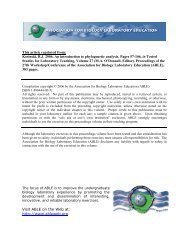A Quantitative Study of Litter and Soil Invertebrates - Association for ...
A Quantitative Study of Litter and Soil Invertebrates - Association for ...
A Quantitative Study of Litter and Soil Invertebrates - Association for ...
You also want an ePaper? Increase the reach of your titles
YUMPU automatically turns print PDFs into web optimized ePapers that Google loves.
82<br />
<strong>Litter</strong> <strong>and</strong> <strong>Soil</strong> <strong>Invertebrates</strong><br />
The four-funnel units just described may be stacked one above the other <strong>for</strong> use <strong>and</strong> in storage;<br />
to do so, add a wood strip approximately 16" × 4" × 1/2" to the top outside <strong>of</strong> the end panels so the<br />
strip extends 2" above the upper edge. The bottom end panels <strong>of</strong> one unit fit inside these strips<br />
atop the end panels <strong>of</strong> the bottom unit. A four-outlet power bar is convenient to distribute<br />
electricity to the four light-reflector units.<br />
A satisfactory Berlese funnel unit, minus the light-reflector, is available commercially from<br />
Carolina Biological Supply Co. (#65-4148); the funnel support <strong>and</strong> collecting vial are included.<br />
Sample Site <strong>and</strong> Sample-Taking Procedure<br />
Any site with organic matter covering a soil surface can be sampled. Those with<br />
accumulations <strong>of</strong> organic debris <strong>and</strong> a minimum <strong>of</strong> disturbances yield greater numbers <strong>and</strong><br />
diversity <strong>of</strong> organisms than barer or disturbed sites. The sod <strong>of</strong> fence rows, lawns, <strong>and</strong> pastures<br />
are productive. Even the very dry, sparse material beneath cacti in deserts have produced an<br />
impressive assemblage <strong>of</strong> <strong>for</strong>ms. The best kind <strong>of</strong> sample to take <strong>for</strong> both Berlese sorting <strong>and</strong> live<br />
observation is <strong>for</strong>est floor where the litter accumulates <strong>and</strong> exhibits seasonal stratification.<br />
Somewhat surprisingly, sample taking is not limited to any particular season <strong>of</strong> the year. In<br />
general, moisture <strong>and</strong> warm temperatures promote growth <strong>and</strong> reproduction <strong>of</strong> litter organisms.<br />
However, amazingly high populations <strong>and</strong> level <strong>of</strong> activity continue into the fall <strong>and</strong> cold <strong>of</strong> winter<br />
in temperate zones. If there is a snow cover that falls be<strong>for</strong>e hard freezes occur the litter<br />
temperature remains at or above freezing <strong>and</strong> organisms continue activity. Sometimes the richest<br />
samples are found in winter.<br />
Collecting the sample is easy: (1) Gather what is desired into a plastic bag, transport to the<br />
funnel unit, <strong>and</strong> place it on the hardware-cloth floor <strong>of</strong> the funnel. (2) Turn on the light, place the<br />
collection bottle containing alcohol under the funnel <strong>and</strong> you are in business.<br />
Several considerations about the make-up <strong>of</strong> the sample may be helpful, however. Funnel<br />
extraction works best on organisms that are ambulatory <strong>and</strong> are not extremely dependent on water.<br />
Most nematodes <strong>and</strong> other small soil invertebrates are simply not able to make the trek from their<br />
location in the sample down the funnel wall <strong>and</strong> into the alcohol <strong>of</strong> the collecting bottle. Except<br />
<strong>for</strong> nematodes, most other types <strong>of</strong> invertebrates characteristic <strong>of</strong> litter <strong>and</strong> the upper soil-litter<br />
interface will be observable in the Berlese funnel extraction sample. Even mites <strong>and</strong> collembola<br />
shorter than 1 mm in length are represented. A detailed discussion <strong>of</strong> funnel extraction efficiency,<br />
sample h<strong>and</strong>ling techniques, <strong>and</strong> collection biases applied to specific groups <strong>of</strong> invertebrates may<br />
be found in Tamura (1976).<br />
The kind <strong>of</strong> sample I recommend <strong>for</strong> study is a quantitative one that includes all the litter <strong>and</strong><br />
only the soil that is mixed with decaying organic matter in the litter-soil interface. Use a wood<br />
frame (see Figure 4.1) to define a certain surface area, <strong>for</strong> example, 10 cm × 20 cm. Using a<br />
serrated knife, cut through the litter <strong>and</strong> into the soil along this frame in much the same way one<br />
would cut a rectangular piece out <strong>of</strong> the center <strong>of</strong> a sheet cake. Using your fingers <strong>and</strong> a minimum<br />
<strong>of</strong> disturbance, remove the sample to a plastic bag. Place soil crumbs, etc., that are part <strong>of</strong> the<br />
sample in the bag. Enclose a label with the sample, <strong>for</strong> identification, <strong>and</strong> tie to prevent<br />
desiccation. The sample may be stored in a refrigerator or even at room temperature <strong>for</strong> several<br />
days if necessary.<br />
When pouring the sample onto the hardware cloth <strong>of</strong> the funnel, fine particles invariably fall<br />
through the hardware cloth. Use a finger bowl or other suitable container under the small opening<br />
<strong>of</strong> the funnel to collect that material. Place another container under the funnel <strong>and</strong> return this<br />
fallen-through material to the sample. Repeat this procedure. Make sure part <strong>of</strong> the sample has<br />
not lodged just above the lower orifice <strong>of</strong> the funnel. When all the sample is perched on the<br />
hardware cloth, rap the funnel lightly to dislodge pieces just ready to fall <strong>and</strong> return them to the
















